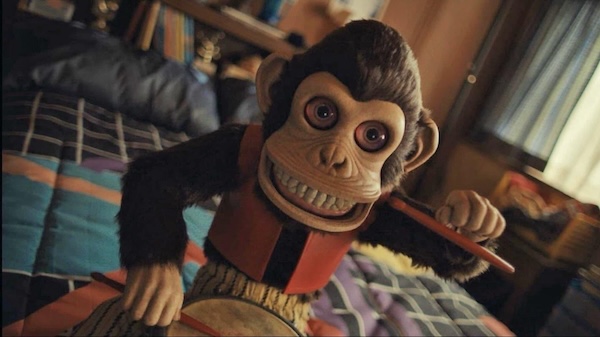Film Review: “The Monkey” — A Hilariously Sinister Simian
By Michael Marano
The Monkey is a delightful exercise in black humor.
The Monkey, directed by Osgood Perkins. Screening at movie houses throughout New England

The eponymous creature of doom in The Monkey.
I don’t wanna be one of those critics who reads too much into a filmmaker’s biography. There’s a little “1970s Pop Psychology” to the practice, but….
Osgood Perkins’s adaptation of Stephen King’s “The Monk,ey” which the director transforms from a lean short story about grief and loss into a grotesque, Looney Tunes-like meditation on the randomness, sadism, and cruelty of sudden death, begins with a (very funny and gross) scene involving fire, fatality, and an airline pilot.
Perkins’s mom, Berry Berenson, died in a plane crash.
Specifically, American Airlines Flight 11, which was crashed into the World Trade Center on 9/11.
She died one day before the anniversary of her husband Tony Perkins’s death from AIDS, after his condition had been leaked without his knowledge to the National Enquirer.
The family, households in general, and secrets form the backbone of a lot of Perkins’s very somber and dark and scary horror films, such as The Blackcoat’s Daughter, I Am the Pretty Thing That Lives in the House, and Longlegs.
With The Monkey, Perkins leaves this backbone as twisted, snapped, and hilariously broken as Wile E. Coyote’s spine after a Chuck Jones boulder has landed on it from a great and whistling height.
While I had some issues with last year’s surprise hit Longlegs — I liked it, but it’s my least favorite of Perkins’s movies — there were moments that were … kinda funny. Nic Cage’s Glam Rock, Marc Bolan-quoting, “Hail Satan!” freak-a-zoid killer, who had the demeanor of a Romper Room TV kiddie host crossed with a subway demon from Jacob’s Ladder, made me chuckle. Chuckle in the way that the cannibal brothers from Tobe Hooper’s Texas Chainsaw movies make me chuckle and that made a bunch of people at the matinee of Longlegs I attended give me “What the fuck Dude?!” looks. And local girl Alicia Witt’s turn as a messed-up mom in an isolated house (the most messed-up horror movie mom in an isolated house since… errr… Tony Perkins’s mom in Psycho) worked because she brought a tiny bit of humor to the role. The All-American Sweetheart star of a bajillion Hallmark movies was mutated into every mom of every grammar school kid whose weird-smelling house you visited and who made you feel uneasy as she served you Fluffernutters blown up to Kaiju extremes. It’s a vile outrage that Witt wasn’t nominated for an Oscar for the role — but never mind.
It’s that “blowing up to extremes” that makes The Monkey such a delicious banquet of gross-outs. Perkins doesn’t just exaggerate the randomness of death to cruel extremes. He also exaggerates the cruel extremes of family connections. There’s not a single healthy familial relationship in this movie. Perkins not only looks at anatomical grotesques with glee, but emotional abnormalities as well. Regarding this issue, the movie’s warped logic can handle a grown-ass man wearing clothes meant for a child — and that is the least messed up thing in The Monkey.
For those five or six of you who didn’t read “The Monkey” during study hall, the premise here is there’s a toy monkey that, each time it’s wound up and activated, somebody dies. Badly. In the short story, the monkey clashes cymbals. Here, because the cymbal-clashing monkey has apparently been copyrighted by Disney since its appearance in a Toy Story movie, the wind-up monkey beats a drum.
King takes the concept and transforms it into a redemptive tale about father/son connection in the face of bereavement.
Perkins makes The Monkey an essay on shell shock, not just in the face of physical violence, but the psychological violence of just living with crazed relatives. King has this thing about legacies — think of his thematizing of alcoholism in The Shining. King’s wind-up monkey is a curse, an intrusion that turns into a family legacy, sort of like W.W. Jacobs’s classic story “The Monkey’s Paw.” Perkins’s take on the wind-up monkey suggests that it is not alien to the family. That it didn’t generate the horrible domestic reality on display, but is a manifestation of these dark energies. The cruelty of the monkey and the deaths it foretells fits snugly into the homes the toy disrupts. Catastrophic and splattery deaths, demises well suited for an Omen or Final Destination movie, are as organic to the dysfunctional households of The Monkey as are their crappy carpets and worn-out quilts. Like I said, the deaths are catastrophic. And they’re splattery. But, given the psychological framework of the characters’ reality, they make a perverted kind of sense. There’s an inevitability to the deaths that makes them all hit like well-earned punchlines.
This internal logic, that death is as cruel and organic as two brothers hating each other, allows Perkins to have a shit-ton of fun with his carnage and psychological abuse. Creepy twins peering down a well conjures up a quote of The Other. During a showdown with the monkey there are musical quotes of what sounds like themes from a spaghetti western. Every Stephen King story set in a high school requires bullies, of course. But Perkins jumps in with both feet and treats us to horrible girl bullies, modern iterations of the “Plug It Up!” thugs in Carrie.
The Monkey is a delightful exercise in black humor, whose antecedent is not just the King short story, but — in its confrontation with death and how it can inspire morbid laughs — the “Chuckles Bites the Dust” episode of The Mary Tyler Moore Show.
“A little song, a little dance, a creepy monkey in your pants.”
Horror writer, critic, and personal trainer Michael Marano (www.BluePencilMike.com) was weirded out by Gordy the Chimp in Jordan Peele’s NOPE, which featured a cameo by Osgood Perkins. Coincidence?

Thanks for sharing